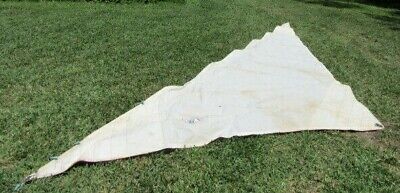@srimes
Like most light-weight trailerables, the Mac 26D will be on its ear with a #3 105% jib in 18-25 kts, even with 2 reefs in the mainsail. I assume the boat uses hank on sails and his smallest is a 105% or so. So it’s a good idea to have a small jib for strong winds in this wind range sailing off the Oregon coast.
I’d recommend around a 80% LP jib, with a luff of approx 80% of maximum hoist on the luff. About 65 -72 sf or so That would be about the right size for a high wind (#4) jib for a Mac26D. 6.5 - 7.0 oz good quality dacron would be the right strength. A used, small jib from a smaller boat will probably be 4-5 oz dacron. That isn't durable enough a used 4 or 5 oz sail may rip in use.
It's very important that the clew is the right height to sheet properly to the sheet fairlead on the cabintop. This will ensure the proper amount of twist by providing the right amount of tension on the leech and foot. Figuring out the clew height takes some sailmaker knowlege. If the clew height isn't right the sail will be worse than going bare headed.
Judy B
Retired Sailmaker.
Like most light-weight trailerables, the Mac 26D will be on its ear with a #3 105% jib in 18-25 kts, even with 2 reefs in the mainsail. I assume the boat uses hank on sails and his smallest is a 105% or so. So it’s a good idea to have a small jib for strong winds in this wind range sailing off the Oregon coast.
I’d recommend around a 80% LP jib, with a luff of approx 80% of maximum hoist on the luff. About 65 -72 sf or so That would be about the right size for a high wind (#4) jib for a Mac26D. 6.5 - 7.0 oz good quality dacron would be the right strength. A used, small jib from a smaller boat will probably be 4-5 oz dacron. That isn't durable enough a used 4 or 5 oz sail may rip in use.
It's very important that the clew is the right height to sheet properly to the sheet fairlead on the cabintop. This will ensure the proper amount of twist by providing the right amount of tension on the leech and foot. Figuring out the clew height takes some sailmaker knowlege. If the clew height isn't right the sail will be worse than going bare headed.
Judy B
Retired Sailmaker.
Last edited:



